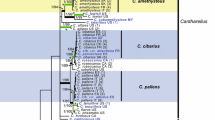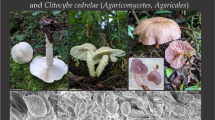Abstract
The authors present a combined morphological and molecular approach of the genus Cantharellus in Africa. Morphological descriptions and detailed illustrations are provided for five new species from the Zambezian savannah woodlands in tropical Africa: C. afrocibarius, C. gracilis, C. humidicolus, C. miomboensis and C. tanzanicus. A maximum likelihood analysis of tef-1 sequences obtained for 83 collections of Cantharellus that are representative of all major groups in world wide Cantharellus, places a total of 13 African chanterelles, including the five newly described taxa. The recognition of a separate genus Afrocantharellus is rejected. An identification key based on the re-examination of all existing type material is provided for all presently known African Cantharellus.






Similar content being viewed by others
References
Buyck B (1994) Ubwoba: les champignons comestibles de l’ouest du Burundi. Admin Gén Coop Dévelopm 34:123. Publications Agricoles, Bruxelles
Buyck B (2012) One neo- and four epitypifications for Cantharellus species from tropical African savannah woodlands. Cryptogam Mycol 33(1):11–17
Buyck B, Hofstetter V (2008) A multigene phylogeny for worldwide Cantharellus (MSA 2008 Abstracts). Inoculum 59(4):22
Buyck B, Hofstetter V (2011) The contribution of tef-1 sequences for species delimitation in the Cantharellus cibarius complex in the southeastern USA. Fungal Divers 49(1):35–46
Buyck B, Eyssartier G, Kivaisi A (2000) Addition to the inventory of the genus Cantharellus (Basidiomycotina, Cantharellaceae) in Tanzania. Nova Hedwig 71(3/4):491–502
Buyck B, Lewis DP, Eyssartier G, Hofstetter V (2010) Cantharellus quercophilus sp.nov. and its comparison to other small, yellow or brown American chanterelles. Cryptogam Mycol 31(1):17–33
Buyck B, Cruaud C, Couloux A, Hofstetter V (2011) Cantharellus texensis sp. nov. from Texas, a southern lookalike of C. cinnabarinus revealed by tef-1 sequence data. Mycologia 103:1037–1046
Buyck B, Randrianjohany E, Eyssartier G (2012) Observations on some enigmatic Cantharellus (Cantharellales, Basidiomycota) with lilac-violaceous tints from Africa and Madagascar. Cryptogam Mycol 33(2):167–179
De Kesel A, Yorou NS, Buyck B (2011) Cantharellus solidus, a new species from Benin (West-Africa) with a smooth hymenium. Cryptogam Mycol 32(3):277–283
Eyi Ndong HE, Degreef J, De Kesel A (2011) Champignons comestibles des forêts denses d’Afrique Centrale. Taxonomie et identification. ABC Taxa 10, 253 pp. Brussels
Eyssartier G (2001) Vers une monographie du genre Cantharellus Adans.:Fr. 259 p. Dissertation, National History Museum Paris
Eyssartier G, Buyck B (1998) Contribution à la systématique du genre Cantharellus en Afrique tropicale: étude de quelques espèces rouges. Belg J Bot 131(2):139–149
Eyssartier G, Buyck B (2001a) Notes on the Australian species described in the genus Cantharellus. Aust Syst Bot 14(3):587–598
Eyssartier G, Buyck B (2001b) Note nomenclaturale et systématique sur le genre Cantharellus. Doc Mycol 31(121):55–56
Eyssartier G, Buyck B, Verbeken A (2002) Cantharellus conspicuus sp. nov. Cryptogam Mycol 23(2):95–102
Felsenstein J (1985) Confidence limits on phylogenies: an approach using the bootstrap. Mol Evol 39:783–791
Foster PG, Hickey DA (1999) Compositional bias may affect both DNA-based and protein-based phylogenetic reconstructions. J Mol Evol 48:284–290
Heinemann P (1958) Champignons récoltés au Congo Belge par Madame M. Goossens-Fontana, III. Cantharellineae. Bull Jard Bot État Brux 28(4):385–438
Heinemann P (1959) Cantharellineae. Flore iconogr champignons. Congo 8:153–165, pl. 26–28
Heinemann P (1966) Cantharellineae du Katanga. Bull Jard Bot État Brux 36:352–365
Hofstetter V, Clémençon H, Vilgalys R, Moncalvo JM (2002) Phylogenetic analyses of the Lyophylleae (Agaricales, Basidiomycetes) based on nuclear and mitochondrial rDNA sequences. Mycol Res 106(9):1043–1059
Huelsenbeck JP, Ronquist F (2001) MRBAYES: Bayesian inference of phylogeny. Bioinformatics 17:754–755
Kornerup A, Wanscher JH (1978) Methuen handbook of colour, 3rd edn. 30 pl., Methuen Co. Ltd, London, 252 p
Morehouse EA, James TY, Ganley ARD, Vilgalys R, Berger L, Murphy PJ, Longcore JE (2003) Multilocus sequence typing suggests the chytrid pathogen of amphibians is a recently emerged clone. Mol Ecol 12:395–403
Stamatakis A (2006) RAxML-VI-HPC: maximum likelihood-based phylogenetic analyses with thousands of taxa and mixed models. Bioinformatics 22(21):2688–2690
Stamatakis A, Hoover P, Rougemont J (2008) A rapid bootstrap algorithm for the RAxML web servers. Syst Biol 57(5):758–771
Tibuhwa DD, Buyck B, Kivaisi AK, Tibell L (2008) Cantharellus fistulosus sp. nov. from Tanzania. Cryptogam Mycol 29:129–135
Tibuhwa DD, Savic J, Tibell L, Kivaisi A (2012) Afrocantharellus gen. stat. nov. is part of a rich diversity of African Cantharellaceae. IMA Fungus 3(1):25–38
Acknowledgments
We are grateful to the staff members of AMU in Dar-es-Salaam for logistic support and field assistance, and to L. Mwasumbi and F.M. Mbago for their botanical expertise. The field work in Tanzania was financed by SIDA/SAREC under the «Propagation and phytochemical studies of endangered or economically important plants and fungi of Tanzania » project. The sequencing for this study was performed by C. Cruaud at the Genoscope or “Consortium National de Recherche en Génomique” near Paris (France) as part of the agreement n°2005/67 on the project “Macrophylogeny of life” between the Genoscope and the “service de systématique moléculaire” (CNRS IFR 101) of the Muséum National d’Histoire Naturelle and receives continuing support from the ATM-project “Barcode of life” (Dirs. L. Legall and S. Samadi).
Author information
Authors and Affiliations
Corresponding author
Electronic supplementary material
Below is the link to the electronic supplementary material.
ESM 1
(NEX 95 kb)
Rights and permissions
About this article
Cite this article
Buyck, B., Kauff, F., Cruaud, C. et al. Molecular evidence for novel Cantharellus (Cantharellales, Basidiomycota) from tropical African miombo woodland and a key to all tropical African chanterelles. Fungal Diversity 58, 281–298 (2013). https://doi.org/10.1007/s13225-012-0215-4
Received:
Accepted:
Published:
Issue Date:
DOI: https://doi.org/10.1007/s13225-012-0215-4




